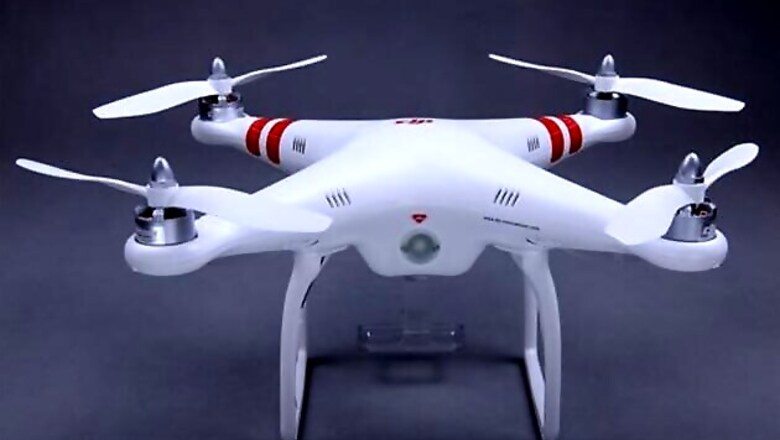
views
Simrishamn: Unmanned aircraft, also known as drones, are revolutionising warfare. Now, some of that technology is coming home from the war, to amuse us and give us an aerial perspective on our surroundings.
I've been trying out a helicopter-type drone called the Phantom this summer. It's been an eye-opener in many ways. It's easy to see these agile, relatively stable aircraft being put to a number of uses, from aerial photography to package delivery - at least once the dangers can be managed and the legal issues worked through.
The video camera on the Phantom also lets me see in a new way a patch of Swedish countryside that I've been to every year since I was a child. It wasn't a huge epiphany, but it was interesting to see a well-known place from a completely new angle.
The $700 Phantom, made by a Chinese company called DJI, is at the forefront of bringing drone technology to the masses.
Roughly a foot in diameter, the four-propeller craft is sold as a complete unit with only minimal assembly required. This hasn't been the norm in the industry. The Phantom could be to drones what the Apple II was to computing more than three decades ago - offering one of the first complete, integrated PCs. In any case, some drone enthusiasts consider the Phantom a major milestone.
The Phantom doesn't come with a built-in camera, but it does have a holder for a GoPro action camcorder, which is what I used. These cameras cost about $200.
Remote-control aircraft have been around for decades. What's different this time around?
First, the aircraft are much easier to fly, thanks to battery technology, electronics and GPS. The Phantom uses a GPS chip to stay steady in the air, even in a wind, and can stay up for nearly ten minutes on a single charge of its battery, which uses the same energy-dense technology as smartphones.
The second revolution is "first-person view," or FPV. That's when the user can see out of the drone's camera as it's flying, freeing the user to send the aircraft out of eyesight and making it easier to capture good video. The military uses advanced FPV to keep drones on patrol over Afghanistan for hours, thousands of miles away from their "pilots." It vastly expands the range and usefulness of remote-controlled aircraft. It also expands the amount of mischief you can cause with them, from spying to egg-dropping.
The Phantom is not equipped for FPV out of the box, and I didn't try any of the $200-plus kits that are available. I had to keep my eyes on the drone and could examine the captured video only after the aircraft was safely back on the ground. This was the drone experience "lite," but it was an intriguing introduction.
So where to try this thing? In New York City, where I live, that's a tough question. The city parks don't allow flying machines of any kind without permits, and that's probably a good thing. The Phantom would hurt if it crashed into you, and the spinning propeller blades could cause real damage to your eyes.
Outside major cities, the Federal Aviation Administration allows remote-control aircraft as long as they're flown for non-commercial purposes, stay below 400 feet and away from "real" aircraft. A new law passed last year will make it easier to get a license for commercial and government drone use by 2015.
In any case, I happened to be heading on vacation to the Swedish countryside, so that's where I flew it.
On my first try, the four propellers spun up, and the Phantom jumped into the air in a stiff breeze, which it seemed unable or unwilling to counteract. To prevent it from flying away, I brought it down quickly - too quickly. It lost a propeller, never to be found again, as it cartwheeled over the turf. Luckily, it ships with replacements.
The second flight went much better. The drone hovered nicely, and I got the hang of the controls - up, down, left, right, spin around.
The drone worked well for most the following 20-odd flights, but it would still occasionally dart off in a random direction right from the take-off, just as it did the first time, forcing an emergency "landing."
The airframe proved very sturdy, but the propellers were getting scrubbed pretty hard in these crashes. I had to install a set of plastic propeller guards, costing $15. I consider this a must-have accessory, one I would have liked to see in the original package.
Once, I sent the drone straight up to see how far it could go. I stopped it when I could hardly make it out anymore. Based on the camera footage, I estimate the altitude at about 1,000 feet. It could have gone higher, but I feared losing control of it because I couldn't see it, or feared running out of battery power on the descent.
The more interesting videos were captured when flying low. They came out well, except that the vibration of the propellers causes the image to jiggle in waves, left to right across the screen. There are camera-mounts available that are supposed to minimize this effect. You certainly want to get rid of it if you're using the video for any professional purpose.
Though it may be a groundbreaking drone in terms of accessibility, the Phantom still feels like a first-generation product, one that enthusiasts will love but rank amateurs will be baffled by. The flight computer is smart, but the remote is a "dumb," conventional model that doesn't receive any information from the drone. Instead, the drone communicates things like GPS signal strengths and the need for compass calibration through three colored LEDs on the airframe. The user is supposed to watch them blinking, then match up the patterns with the manual. For instance, six green flashes means the sensors are out of whack, but a continuous string of green flashes means it wants to record a "home" point. This is not a friendly, human-centric way to communicate.
The Phantom was a lot of fun to fly, but as soon as I wanted to record some really interesting video, it failed me. I wanted to take it up over a rare gathering of extended family and then record the sun rising over some ancient megaliths the next day. But the drone started spinning uncontrollably around its axis, rendering it useless. This may be a calibration issue that I could deal with by connecting the internal flight computer to my Windows PC, but I haven't gotten there.
It's another illustration of how the Phantom is still more of a hobbyist product than a true consumer product. Still, it was fun while it lasted, and it points to more fun ahead, with friendlier drones.

















Comments
0 comment